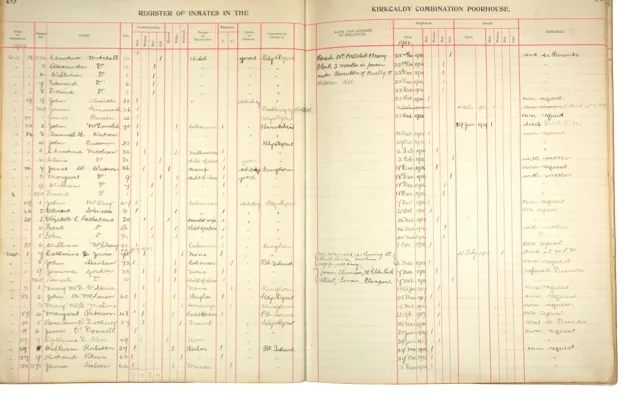Many of our Scottish ancestors sought poor relief from the Church or the state in straitened times. The resulting records can assist us in identifying times of ancestral adversity, and in some cases an approximate date of death for our forebears when the payments ceased.
Prior to 1845, the kirk session records and parish accounts of many Church of Scotland parishes are filled with notices about the distribution of money to the poor. Some were one-off payments; others received support over many years.
Although the first attempts by the state to deal with poverty date back to 1424, the effective system of poor relief in the country began in 1579 with the passing of an Act of the Scottish Parliament for the “punishment of strong and idle beggars, and relief of the poor and impotent”. This sought to outlaw vagrancy and begging, but also to assist those in genuine need. Responsibility for Poor Law administration was transferred to the kirk sessions in 1597, with additional Acts in 1663 leading to the creation of ‘correction houses’ where paupers unable to find work were committed (although only a few were erected), and in 1672 to strengthen the powers of kirk sessions and parish heritors (landowners) for addressing the issue.
Poor Law records in church records can be vague, simply listing a payment in a list of disbursements at regular intervals, and sometimes with frustratingly vague descriptions of the recipients, for example a woman listed merely as “Widow Fraser”. In some cases, however, registers may indicate when and why a person was admitted to the poor roll.
Access to digitised kirk session registers is available on the Virtual Volumes system at the National Records of Scotland in Edinburgh, and at other designated centres across the country offering access to the Scottish Documents platform. Many can also be accessed digitally through local FamilySearch Family History Centers.
The State takes over
The kirk’s responsibility for the parish poor continued until the 1845 Poor Law (Scotland) Act transferred its role to the state, although in many areas this was not a strict cut-off date.
In the Aberdeenshire parish of Oyne, for example, the kirk session registers show payments to a parishioner called Ernest Clerihue long after the Act was passed, with a final payment of 13s 10d on 27 June 1847.
The 1845 Act was passed 11 years after a similar exercise in England and Wales (1834), and seven years after Ireland (1838). Although the English, Welsh and Irish systems were very similar, Scotland approached the needs of its population in a somewhat different manner.
Instead of creating Poor Law unions with oversight by boards of guardians, a system of ‘parochial boards’ was established for every parish in Scotland, which was to report to a central Board of Supervision in Edinburgh.
Rather than setting up workhouses as a punitive deterrent for those out of work seeking poor relief, and administering a workhouse test, Scotland administered a series of ‘poorhouses’ to treat those who were sick or destitute, in addition to the provision of ‘outdoor relief’. Although some parishes operated their own individual poorhouses, many parishes pooled resources to establish ‘combination workhouses’ serving a wider area.
The decision on whether or not to admit somebody into a poorhouse, or to give them outdoor relief, was made by an inspector of the poor. Poorhouses were not used for the relief of any person able to work, and any applicants denied relief had the right to appeal through the sheriff courts.
The system continued to evolve, with parochial boards replaced in 1894 by parish councils and the Local Government Board for Scotland, with further reforms in 1929 and 1948 passing the system through to local authority control.
Many facts were taken into consideration when administering poor relief, both indoor and outdoor, including the perceived legitimacy of the claim; the feasibility of recouping the expenditure; the moral nature of the applicant; and, importantly, whether the applicant had the right of settlement in a parish, which was gained at birth or by five years’ residence.
In some detailed records, for example those for Glasgow, you will often find a potted history of every residence that an applicant has previously lived within.
In particular, for those who had arrived from Ireland, such detailed information can provide a county or parish of origin, where a census record may simply have stated that the applicant had been born in Ireland – something any researcher will welcome.

How to find Scottish Poor Law records
To identify the relevant poorhouse for a particular parish in Scotland, and the location of any surviving poor relief records, consult Peter Higginbotham’s excellent website The Workhouse, while the NRS has a guide to Poor Law records, both prior to 1845 and after. In addition, genealogist Kirsty Wilkinson has produced a further guide to holdings identified in archives across the country.
Note that the level of detail contained in the registers varies. The most detailed records can be found in Glasgow City Archives.
Some records are also now available online, through a variety of sources. For example, Ancestry has made available records for North Lanarkshire for 1849–1917, with holdings from the parochial boards of Borthwell, Cambusnethan, Dalziel, New Monkland and Shotts, and for Kirkcaldy in Fife for 1888–1912.
Findmypast also hosts three collections, Dundee Poor Lists 1821–1840, Dundee Poor Relief Assessments 1822–1839 and Highland Poor Law 1845–1929 (from a database sourced from the Moray & Nairn Family History Society with records for Invernessshire, Moray, Ross and Cromarty, and Sutherland).
Records for Dundee can also be found for free. For Paisley, there is an index of applications for 1839–1942, and Stirling Archives hosts poor relief indexes for much of the county. A database for Borders-based parishes can also be found on the Borders Family History Society’s website.
Many Irish and English applicants claiming relief or admission in Scotland were sent back to Ireland or back over the border to England if no source for recompense could be identified – only a medical note could prevent a removal if such a decision was reached. The House of Commons Parliamentary Papers website, freely accessible through many subscribing libraries, contains detailed letters and annual reports from the second half of the 19th century recounting vast lists of people on a parish-by-parish basis who were returned in this way.

